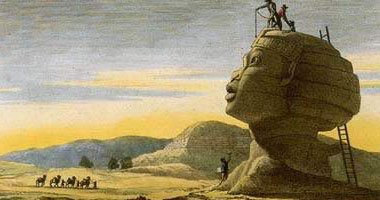The Great Sphinx: A Monument to Mystery
The Great Sphinx of Giza, a colossal statue carved from a single piece of limestone, stands as a sentinel overlooking the Giza Plateau. Its enigmatic nature, combined with its imposing size and ancient origins, has captivated humanity for millennia. The Sphinx depicts a lion’s body with a human head, and it is estimated to have been constructed around 4,500 years ago during the reign of Pharaoh Khafre. One of the most intriguing aspects of the Sphinx is the missing nose. if you would like to go closer and touch the Sphinx. Our VIP tour inside the Great Sphinx allows you to “touch its surface.”
The Dream Stele
A significant feature of the Sphinx complex is the Dream Stele, a granite slab nestled between the statue’s paws. This ancient artifact, erected by Pharaoh Thutmose IV (c. 1400-1390 BCE), recounts a dream in which the Sphinx vowed to restore its former glory if Thutmose would clear away the sand that had buried it. In fulfillment of this promise, Thutmose IV undertook extensive restoration work, solidifying his claim to the pharaohs. You can Discover the captivating stories behind the Dream Stele through our VIP Tour. As the Sphinx will be yours for 1-hour
Hidden Tunnels Beneath the Sphinx
Beneath the Sphinx’s colossal paws lies a network of hidden tunnels that have been the subject of much archaeological exploration. These subterranean passageways, once overlooked, have revealed a labyrinthine system that raises questions about their purpose and significance. Some scholars suggest that the tunnels were used for ritualistic purposes, while others propose a more practical function, such as connecting the Sphinx to nearby structures or serving as a drainage system.
Perring’s Hole and Other Tunnels
One of the most well-known tunnels beneath the Sphinx is Perring’s Hole, named after the 19th-century archaeologist Henry Vyse. This narrow shaft, carved into the Sphinx’s head, was created in an attempt to uncover hidden chambers or artifacts. While Perring’s Hole did not yield any significant discoveries, it remains a fascinating glimpse into the early days of archaeological exploration. Other notable tunnels beneath the Sphinx include the Eastern Shaft, Shaft A, Shaft C, Shaft D, and the Keyhole Shaft. Each of these passageways offers unique insights into the Sphinx’s construction, its potential uses, and the ancient Egyptian civilization that created it.
Shaft A
Atop the Sphinx’s head, the deep hole of Shaft A ignites curious thoughts about its purpose, prompting us to consider its possible link to ancient headgear attachments.
Shaft C
a square passageway terminating at the back of the Sphinx, contributes to its enigma, sparking thoughts on its intended use and importance in history.
Shaft D
Descending to the water table below the Sphinx, Shaft D’s passage beneath the hind paws opens doors to exploration around 4.5 meters below the surface, revealing hidden secrets.
Keyhole Shaft
Enveloped in mystery, the Keyhole Shaft suggests the presence of an incomplete tomb, contributing depth to the Sphinx’s enigmatic history and igniting interest in its undisclosed tale.
The Search for Hidden Chambers
The concept of hidden chambers within the Sphinx has long captivated the public imagination. Although certain chambers have been found, archaeologists and enthusiasts remain fascinated by the prospect of undiscovered spaces beneath the statue. One of the most famous legends is that of the “Hall of Records,” a mythical chamber said to contain ancient knowledge and secrets about the history of humanity. However, despite numerous attempts to locate such a chamber, no concrete evidence has been found to support its existence.
The Enduring Mystery of the Sphinx
In conclusion, the Sphinx of Giza remains an enigmatic monument shrouded in mystery. Beneath its grand structure lie secret tunnels and chambers that provide intriguing insights into the past, unveiling hints about Egyptian engineering, religious beliefs, and cultural customs. Despite numerous unanswered questions about the Sphinx, its lasting allure stands as proof of the enduring impact of human curiosity and imagination.
FAQs
Can I touch sphinx?
Yes, you can touch Sphinx on this exclusive tour. Our VIP tour allows you the opportunity to “touch the sphinx and its surface.” This is a unique experience that is not typically available to most tourists. As a VIP tour, you will be granted access to the Sphinx’s enclosure, allowing you to get closer to the monument than most visitors. You will also have ample opportunities to capture stunning photos of the Sphinx from up close and walk inside the Sphinx, including standing between its paws and examining the Dream Stele. This tour offers a truly unique opportunity to experience the majesty of the Great Sphinx and gain a deeper understanding of ancient Egyptian civilization.
Can I walk inside the Sphinx?
Yes, you can walk inside the Sphinx area. Our exclusive tour grants you access to the Sphinx’s enclosure, a privilege typically denied to most visitors. This allows you to explore the monument up close, touch its ancient surface, and examine the Dream Stele..
Conclusion
As we navigate the depths of the Sphinx’s mysteries, we uncover a tale of ancient aspirations, abandonment, restoration, and the timeless allure of an enigmatic monument. The Sphinx of Giza, with its hidden tunnels and secrets, remains a beacon of fascination, inviting future generations to continue the quest for understanding the secrets held within its ancient embrace.


